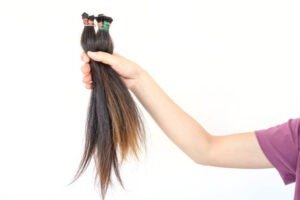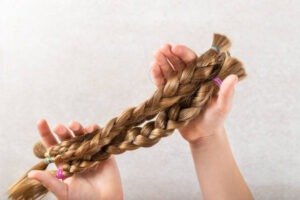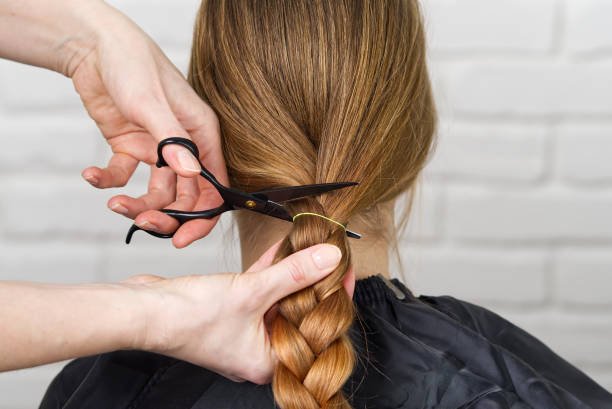How to Donate Your Hair: For many people battling cancer, alopecia, or other medical conditions that cause hair loss, a wig is more than just a covering—it’s a source of confidence, dignity, and hope. Donating your hair is a beautiful way to make a meaningful impact on someone’s life. It doesn’t cost anything except patience and care while growing your hair, but the effect is priceless.
In this detailed guide, we’ll walk you through everything you need to know about donating your hair—why it matters, how to prepare, where to donate, and what to expect during the process.

Why Donate Hair?
Hair loss can be devastating, especially for children and women undergoing chemotherapy or living with conditions like alopecia areata or severe burns. Wigs made from real human hair provide a natural look and feel that synthetic wigs often cannot match.
By donating your hair, you:
-
Help restore confidence to patients going through difficult treatments.
-
Provide comfort to children who may be bullied for looking “different.”
-
Contribute to organizations that create wigs free of cost for patients.
-
Offer a deeply personal gift that can change lives.
In short, your hair donation becomes a symbol of love, kindness, and solidarity.
Who Can Donate Hair?
Almost anyone can donate hair, provided they meet the basic requirements set by hair donation organizations. The criteria may vary slightly, but most have similar guidelines:
-
Minimum length: Typically 8–12 inches, though some organizations accept 6 inches for children’s wigs.
-
Healthy condition: Hair should be clean, dry, and free from lice, mold, or chemical damage.
-
Dyed or treated hair: Many organizations accept colored hair, but bleached or heavily damaged hair is often not allowed.
-
Gray hair: Some charities accept it, while others don’t.
-
Curly, straight, or wavy: All textures are welcome as long as the hair is healthy and meets length requirements.
Step 1: Preparing Your Hair for Donation
Before you grab the scissors, it’s important to prepare your hair properly. Doing so ensures the donated hair stays in the best condition for wig-making.
1. Grow Your Hair with Care
-
Trim split ends regularly to keep the hair healthy.
-
Use mild shampoos and avoid excessive heat styling.
-
Protect hair from harsh sun and pollution as much as possible.
2. Wash and Dry Before Cutting
-
Wash your hair thoroughly with shampoo and conditioner the day you plan to cut it.
-
Make sure your hair is completely dry—wet hair can develop mold during shipping.
3. Section and Secure Your Hair
-
Divide your hair into small ponytails (usually 4–6 sections).
-
Secure each ponytail tightly with hairbands near the scalp and another band near the end.
-
This prevents the hair from tangling and keeps the strands aligned.

4. Cut with Sharp, Clean Scissors
-
Ask a professional hairstylist to cut your hair for neatness.
-
Cut above the top band so the entire ponytail stays intact.
Step 2: Choosing the Right Organization
There are many hair donation organizations across the world. Choosing the right one depends on where you live and what kind of impact you want to make. Here are a few well-known charities:
-
Locks of Love (USA) – Provides hairpieces to financially disadvantaged children suffering from medical hair loss.
-
Wigs for Kids (USA) – Creates custom wigs for children who have lost their hair due to medical issues.
-
Pantene Beautiful Lengths (Global) – Partners with the American Cancer Society to provide free wigs.
-
Hair We Share (USA) – Distributes wigs to both children and adults.
-
Indian Cancer Society (India) – Runs hair donation drives across India for cancer patients.
-
Cope with Cancer – Madat Trust (India) – Uses donated hair to make wigs for cancer patients at no cost.
Things to Check Before Donating
-
Minimum hair length requirement.
-
Whether they accept colored or chemically treated hair.
-
If they provide wigs free of cost (some organizations sell wigs at subsidized rates).
-
Shipping guidelines and address.
Step 3: Packing and Sending Your Hair
Once you’ve cut your ponytail, it’s time to pack it for donation.
-
Place the dry ponytails in a clean, sealed plastic bag.
-
Put the bag inside a padded envelope or box.
-
Include your name, contact details, and a small note of encouragement (optional but heartwarming).
-
Mail it to the organization’s address as per their guidelines.
Some organizations also have drop-off centers or arrange donation drives where you can hand over the hair directly.
Step 4: After the Donation
The moment you donate your hair, you’ve already made a huge difference. But here are some additional ways to maximize your impact:
-
Spread Awareness: Share your experience on social media to inspire others.
-
Encourage Friends: Start a hair donation drive at your school, college, or workplace.
-
Support Financially: If possible, make a small donation along with your hair. Wig-making is expensive, and monetary support helps cover costs.
-
Grow Again: Many people make it a habit to grow and donate hair every few years.
Common Questions About Hair Donation:
1. How long does my hair need to be?
Most organizations require at least 8–12 inches. Check with your chosen charity.
2. Can I donate hair that has been colored or permed?
Yes, if it’s in good condition and not bleached. Always verify with the organization.
3. Can men donate hair?
Absolutely! Hair donation is open to everyone.
4. Will I get paid for donating my hair?
No, genuine hair donation is purely charitable. However, you’ll receive immense emotional reward.
5. How many ponytails are needed to make one wig?
Usually, 6–12 ponytails, depending on the length and thickness.
The Emotional Reward of Donating Hair:
While the act itself is simple, the emotional impact is profound. Imagine a child who has lost her hair due to chemotherapy putting on a wig made from your donation. Suddenly, she smiles again in the mirror, regaining a sense of normalcy. That’s the magic of your kindness.
Hair will grow back—but for someone fighting a life-threatening illness, the hope you give lasts forever.
Donating hair is one of the most selfless gifts you can give. It requires patience, care, and a little bit of courage, but the reward is immeasurable. By following the right steps—growing, cutting, and sending your hair to a trusted organization—you can help restore confidence and dignity to those who need it most.
So, if you’ve ever thought about making a difference in someone’s life without spending a penny, consider donating your hair. Your simple act of kindness might be the reason someone feels beautiful, strong, and hopeful again.
✅ Remember: Your hair can be someone’s hope. Start today.
Lifestyle सम्बन्धी ऐसी और भी जानकारियों और खबरों के लिए हमारे साथ जुड़े रहें! Khabari bandhu पर पढ़ें देश-दुनिया की ताज़ा ख़बरें — एजुकेशन, मनोरंजन, बिज़नेस, धर्म, क्रिकेट, राशिफल और भी बहुत कुछ।

